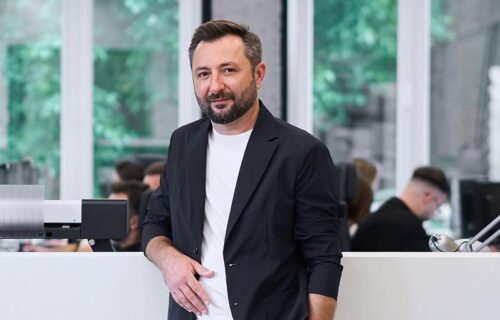With projects ranging from landmark retail expansions to international hospitality brands and cultural regeneration, DRS-Architects has established itself as a key player in Romania’s evolving built environment. CIJ EUROPE reached out to Andrei Lefter, Founder & Managing Partner, about how his firm balances modern retail demands with civic identity, adapts global brands like Primark to the local market, and integrates sustainability as a guiding principle in architecture.
Q: How does your design for the Arena Mall expansion balance modern retail demands with creating a landmark space that strengthens Bacău’s urban identity?
The Arena Mall expansion was conceived as more than just additional retail space; it aims to reinforce the mall’s role within Bacău’s urban fabric. The design incorporates contemporary retail needs—flagship stores, first-to-market brands, and expanded leisure and entertainment zones—while interiors are shaped around comfort, natural light, and clarity to create a high-quality visitor experience.
Equally, the project is designed as a civic landmark. A newly introduced external terrace functions as a public square, connecting directly with the surrounding city and offering a flexible venue for events, social interaction, and community engagement. This integration enhances accessibility and inclusivity, complementing the existing mall and creating long-term value for the city. Its contemporary, expressive architecture ensures visibility and recognition, turning the development into a point of pride for residents and a symbol of Bacău’s vitality.
By coupling functionality with iconic design, the expansion elevates regional retail standards while supporting the city’s identity as a dynamic urban center. With the future integration of a hotel and residential complex, the site will evolve into a mixed-use landmark and catalyst for economic and community growth.
Q: The Mercure Hotel project integrates global hospitality standards with strong local cultural references. How do you approach blending tradition and modernity in hospitality architecture, and what challenges come with that?
For us, hospitality is about connecting people both to comfort and to the spirit of place. In the Mercure Hotel project, we reinterpreted traditional design principles within the interiors to evoke belonging and cultural resonance, while ensuring spatial clarity and material choices aligned with international hospitality standards.
The building itself was designed in dialogue with its natural surroundings. The orientation of wings and guest rooms toward the lake ensures that the experience of place is both visual and emotional. In this way, the hotel responds to the expectations of today’s global hospitality sector while maintaining authenticity.
The main challenge lies in balance: avoiding superficial references to tradition while ensuring operational efficiency and alignment with brand standards. The result is a hotel that is locally inspired yet globally recognizable—an authentic and contemporary destination.
Q: As the local partner for Primark, what are the key architectural and regulatory challenges you face in adapting international retail concepts to the Romanian market?
As Primark’s local partner, we act as the link between the mall’s technical team and Primark’s international design and engineering team, adapting projects to Romanian conditions. This includes local specifications, permitting, health and safety regulations, and site supervision.
A significant challenge is aligning international retail concepts with Romania’s regulatory framework. Local building codes, fire safety standards, and accessibility requirements often differ, requiring careful design adaptations without compromising the integrity of the brand concept.
Approval processes also vary between municipalities and can be complex, demanding precise documentation and close coordination to avoid delays. Increasingly stringent sustainability requirements add another dimension, requiring integration of energy efficiency, waste management, and environmentally responsible construction. The key is to ensure these requirements strengthen rather than compromise the overall customer experience.
Q: Many of your recent projects emphasize comfort, authenticity, and sustainable materials. How central is sustainability to your current design philosophy, and how do you see this evolving in Romania’s commercial and hospitality sectors?
Sustainability is now a fundamental part of contemporary architecture, and in Romania, it has become a requirement, particularly with the implementation of NZEB (Nearly Zero Energy Building) standards. For us, sustainability is inseparable from comfort and authenticity. We focus on energy efficiency, durable and locally sourced materials, natural light, and healthy indoor environments to create spaces that are both comfortable and responsible.
In retail and hospitality, sustainability is shifting from a differentiator to a baseline expectation. Projects are now expected to integrate efficiency and environmental responsibility at their core while still delivering engaging, authentic user experiences. Looking ahead, this regulatory and cultural evolution will make sustainable design central to all projects, shaping choices in materials, systems, and urban integration, while maintaining a strong focus on context, identity, and long-term value.
Q: Looking ahead, where do you see the biggest opportunities for DRS-Architects in Romania’s architectural landscape—retail, hospitality, mixed-use, or cultural regeneration projects?
We see significant opportunities across all these sectors. Retail and hospitality are evolving rapidly, shaped by consumer demand for experiences that merge functionality, comfort, and authenticity. Our ability to integrate international standards with local context positions us well in this space.
Mixed-use projects are another major growth area, enabling us to shape urban life holistically by combining living, working, shopping, and leisure. These developments allow us to bring together sustainability, public spaces, and community engagement at a larger scale.
Finally, cultural regeneration is gaining importance, especially in cities with strong historical fabric. Adaptive reuse of heritage buildings can enhance urban identity, support community life, and drive sustainable development.
Ultimately, our biggest opportunities lie in projects that merge design excellence, contextual sensitivity, and long-term value creation—whether in commercial, mixed-use, or cultural sectors—helping us continue to shape meaningful urban environments in Romania.
As Andrei Lefter makes clear, the role of architecture in Romania is shifting from simply delivering functional buildings to creating urban spaces that foster identity, sustainability, and long-term value. Whether through retail, hospitality, mixed-use, or cultural regeneration, DRS-Architects continues to position itself at the intersection of international standards and local context—driving projects that both serve communities and shape the future of Romania’s cities.
© 2025 www.cijeurope.com
